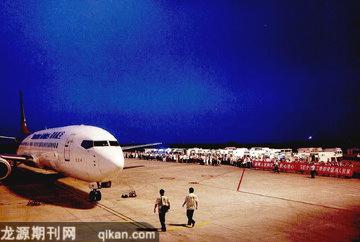An Example for the Corporate World
By staff reporters SUN LI&LIU QIONG

THE moment he felt the tremble, Li Zeyuan knew it must be a devastating earthquake. On May 12 he was in Chongqing on a business trip, and soon learned a magnitude-eight quake had hit nearby Wenchuan. Li Zeyuan is a senior advisor with Shenzhen Airlines, but he used to be a soldier and participated in rescue operations following the devastating Tangshan earthquake of 1976. Experience told him that massive air rescue and relief efforts would be needed for the affected area, since land transport was likely to be seriously impeded by such a major temblor. The 8 oclock news that night confirmed that the Baoji (Shaanxi)-Chengdu railway and highway had both been cut.
Emergency Recall
The moment telecommunications were restored in Chongqing, Li was on the phone to Shenzhen Airlines headquarters, advising them to initiate their contingency response program and organize a group for relief planning.
At the time Jade Cargo International, Shenzhen Airlines cargo joint venture with Lufthansa Cargo and German investment bank DEG, had two Boeing 747-400 transport planes flying domestic routes. Headquarters immediately informed Chinas central government that they could fly rescue missions at any time.
Meanwhile, Li Zeyuan asked that Jade Cargos four other planes be recalled from the U.S.and Europe, but he met opposition from German partners. The four planes had been contracted to fly routes overseas, and violation of the contracts would incur default penalties of RMB 23 million. In addition, the operation of each 747 cargo plane cost Jade Cargo RMB 100,000 per hour. “The Chinese side will shoulder all the losses,” Li Zeyuan told the German partners. The Europeans sent their consent on May 13. That same day, the four planes unloaded their shipments and returned to China.
Shenzhen Airlines also issued orders that its 70 domestic passenger planes should fly rescue materiel and personnel if required. The decision is especially admirable given Shenzhen Airlines is a non-state-owned airline.
Relief Shipments
On the morning of May 13, the day after the earthquake, the staff of Shenzhen Airlines donated more than RMB 1 million on top of the airlines corporate donation. The companys procurement department immediately organized the purchase of relief materiel with the money.
When suppliers learned of the action, they responded enthusiastically, and within four hours more than 20 trucks loaded with tents, bedding, raincoats, drinking water and canned porridge converged on Shenzhen Airlines cargo center. For 10 hours, starting at 2 p.m. on May 13, the 50 staff of the cargo center, assisted by the procurement and catering centers, checked, labeled and loaded the materiel onto two Jade Cargo aircraft. Early on May 14, the aircraft flew to Deyang in the epicenter area, making Shenzhen Airlines the first Shenzhen company to send self-procured relief material.
The airline had already become the first to fly in rescue materiel, when they transported a load of supplies procured by the State Disaster Relief Commission from Tianjin to Chengdu on the afternoon of May 13. The flight was captained by Liu Qinggui, Shenzhen Airlines vice president in charge of flying operations. Liu Hang, deputy secretary of the airlines CPC Committee, arrived at Chengdus Shuangliu Airport beforehand to make arrangements for the shipments arrival and immediate dispatch.
Liu Qinggui is a native of Sichuans Neijiang. More than 40 of his pilots are also from Sichuan, and quite a number are from around the epicenter. Though they each flew into Chengdu several times, none of them asked for leave to visit their relatives. “In the face of disaster, we should stick to our post, and fly as many relief personnel and as much materiel as possible,” said Liu Qinggui on behalf of his flying crews.
Silence Speaks Volumes
At 11 p.m. on May 15, the 82 passengers of Yinchuan-Shenzhen Flight ZH9988 began to board their flight. They had been held up at Yinchuan Airport for more than eight hours. Despite his fatigue, Xu Yue, manager of Shenzhen Airlines Yinchuan Office, personally apologized for the delay. He and his staff had been working for 31 hours non-stop organizing relief shipments. On May 13, Shenzhen Airlines learned that Ningxia Hui Autonomous Region had a shipment of relief materiel and a medical team waiting to go from the regional capital of Yinchuan to Sichuan. The airline immediately volunteered to provide a plane and postponed two passenger flights, including ZH9988, in order to carry out the mission.
On learning of the reason for the delay, passengers expressed their understanding and support. Nevertheless, Xu Yue made a formal apology on board ZH9988, and told passengers that according to company regulations, flight delays that exceeded eight hours qualified for compensation equivalent to the full value of any ticket. When he finished, there was a brief silence before applause erupted in the cabin. None of the passengers made claims.
Flying Ambulances
In the early hours of May 21, Shenzhen Airlines two Boeing 737-900 passenger planes were having their seats and overhead baggage compartments removed. On the night of May 19, Sichuan earthquake relief operation headquarters asked the airline to help transport wounded victims to hospitals outside Sichuan. The airline decided to remodel its two largest passenger planes to carry out the task.
After finishing the days flights, the crew of the two planes immediately plunged into the remodeling work. In five hours, they removed 139 of the 189 passenger seats on each plane, leaving 50 for escorting medics and relatives. Space between the remaining seats could accommodate 30 stretchers.
On the night of May 21, the first Boeing 737-900, carrying 34 seriously wounded victims and 44 escorting passengers, took off from Chengdu. The crew was particularly careful to minimize vibrations and keep the flight gentle. Stewardesses helped medics taking care of the wounded. “Thank you, jiejie (sister). Your company has helped ease my pain,” said a boy from Beichuan Middle School, who had had a leg amputated. The loudspeaker consoled the special passengers: “Though we cannot avoid the challenges thrown at us by nature, love binds us together and gives us hope and confidence that all the hard days will soon be over and all will be fine.” At 1 a.m. the plane landed at Shenzhen Baoan International Airport. Waiting ambulances immediately drove the wounded to city hospitals.
By May 30, Shenzhen Airlines had flown over 150 volunteer relief missions for Sichuan earthquake victims, transporting 3,880 tons of materiel, 350 rescuers, and 1,880 wounded victims and their escorts, setting an example for the whole corporate world.
Shenzhen Airlines Disaster Relief “Firsts”
The first airline to announce unconditional transport support for the disaster zone.
The first airline to volunteer flight services to the central government.
The first airline to use its passenger planes for transporting relief materiel.
The first airline to remodel its passenger planes for transporting the wounded.
The first business to procure and transport relief materiel to the disaster zone.

